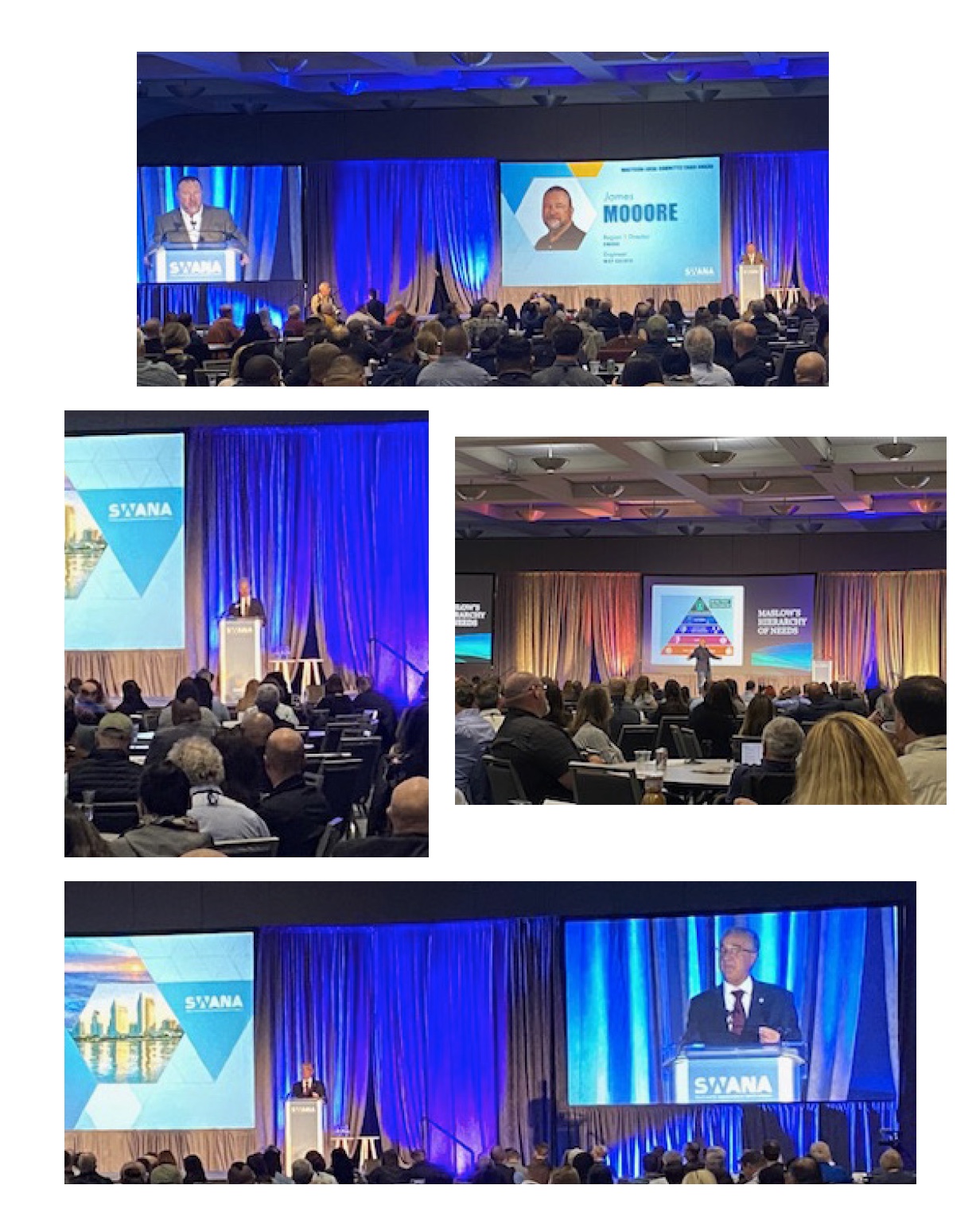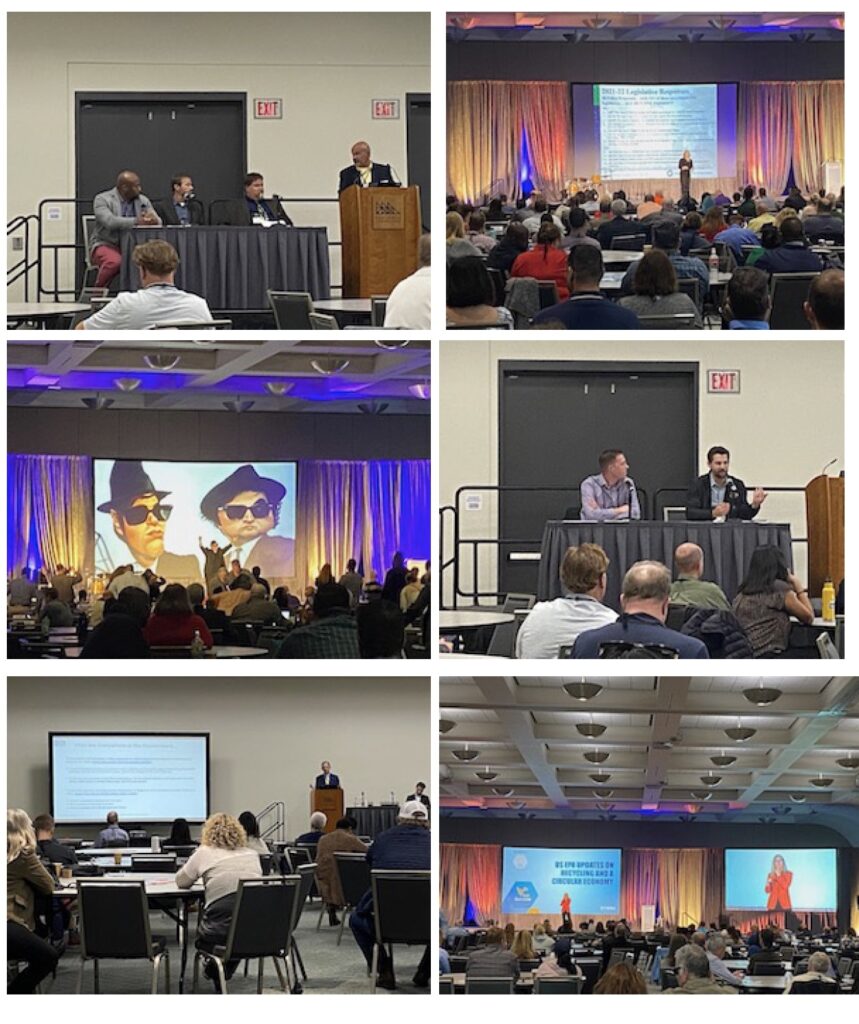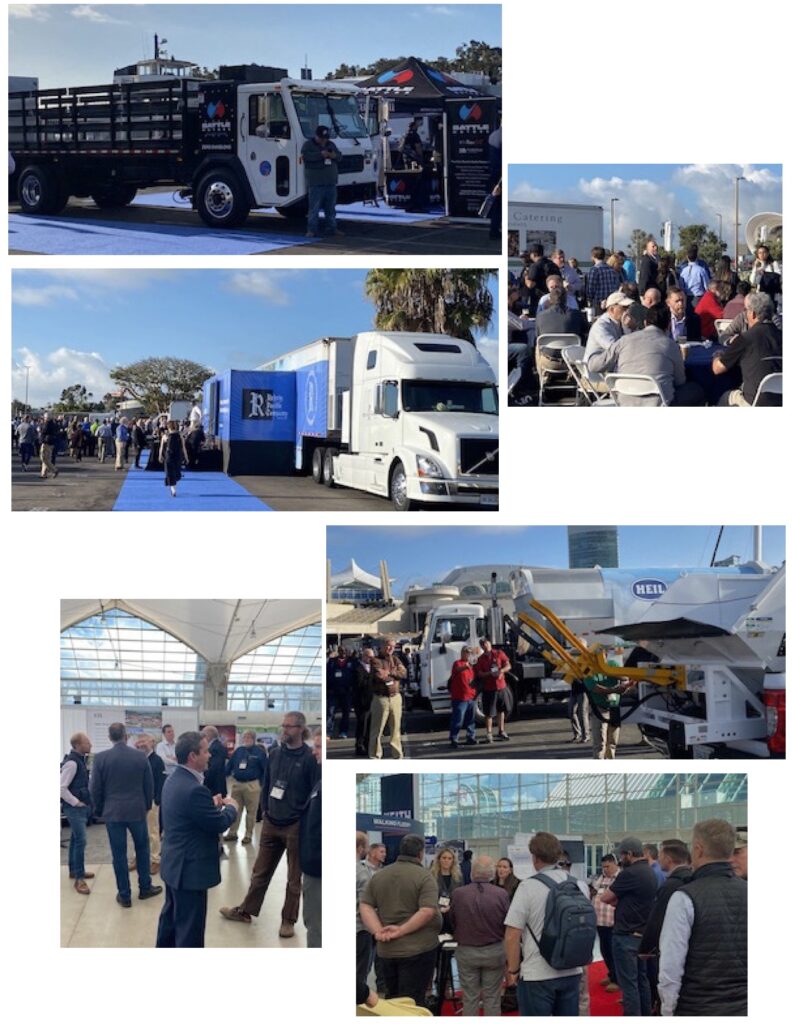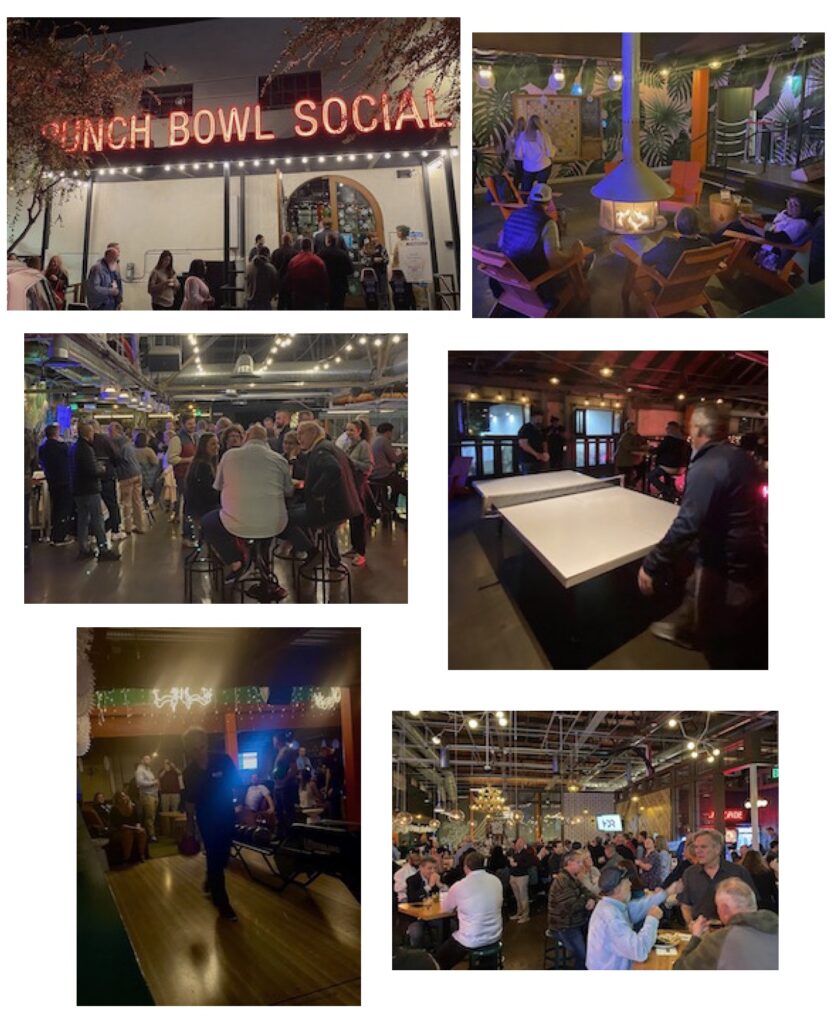WASTECON® 2022 was held this week in sunny San Diego, CA for the first time in more than 15 years and attendees were eager to get into learning and meeting with old (and new) friends, experience new opportunities and see technologies that would help to make their operations more efficient.
Monday Kickoff
On Monday evening, WASTECON® opened with a welcome from SWANA President, Tim Flanagan and then Chapter President James Otter. After that, Dr. Kathryn Sandoe took the stage as emcee and talked about how this event is a place where not only people can have fun and connect, but it is also a space where everyone can come together, meet, and collaborate. So, what will you do with this time, how will we attract more people to the industry and, how do we protect the environment that we’re in. She stressed that people today are looking for meaningful relationships in their work and challenged the audience to have an immersive experience, use the opportunity to capture what is meaningful to you. What do you want to do, see, and learn? She then introduced David Biderman, Executive Director and CEO of SWANA, with a fun fact: his first job was delivering dry cleaning.
SWANA Updates
Biderman took the stage and said that it was a privilege and pleasure to welcome attendees to the event and expressed his appreciation. He stressed that the past few years have challenged us like never before and through it all this great and resilient industry persevered and continued to collect and process waste and recycling material. In 2022, there was a resumption of business—SOAR took place in Kansas City and will be Atlanta in April 2023, SWANA continues to offer on-demand training options. More than 250 solid waste professionals received their verifications this year. SWANA finalized and implemented their strategic plan, which includes the goals of getting waste collection off list of 10 most dangerous jobs, adding more safety content and working with agencies as partners, becoming climate champions, and promoting the solid waste industry as a desirable place to work.
He went on to say that SWANA has not only been at the center of congress decisions, laws, infrastructure grants, common goals, policies, etc., but their Applied Research Foundation has issued several important research papers within the last year. He said thank you to SWANA chapters and all staff, board of directors, advisory board, sponsors, and others for all of their hard work—all have been integral in moving the organization and industry forward. Finally, he stressed that we recognize that the elusive new normal is going to be different but said that SWANA will be there every day to give you the tools you need.
A Councilman’s Welcome
Tim Flanagan spoke on looking back at 40 years when curbside recycling was barley happening. He commented that he stuck with it and did not give up. As a result, he had amazing mentors over the years. This industry makes a difference every day; we are on the front line of sustaining public health, climate change, and resource management. He said while he had many great opportunities over the years, he was grateful that this has been his life’s work and was humbled to be SWANA’s president. He then introduced San Diego Councilman Joe LaCava who shared his experience and gave his thoughts on industry.
After welcoming attendees to San Diego, he talked about the history of the convention center and that has hosted many great events, including being home to Comic-Con. He explained that during pandemic, the convention center was sitting empty but with public health at stake, they turned the venue into a safe haven for those who needed it. He stressed that those in the waste and recycling industry are essential workers. Solid waste did not stop during pandemic and there was more trash to deal with. There are few industries that can boast this level of reliability and hold trust with community that you serve. It takes round-the-clock coordination to have everything running safely and effectively along with the good jobs that the industry provides. He commented that climate action is at the forefront of everything that they do. In August, the city passed landmark climate action plan—renewable energy by 2030. There are six key strategies of which solid waste and circular economy is part of it. There is now a polystyrene ban for takeout food, methane gas tops list to take care of. Environmental services department is helping this along. By increasing annual department budget, including hiring and training new drivers, getting new trucks, and rolling out new carts; 89,000 customers will receive green waste collection for the first time. The organics processing facility in the middle of the city will expand the life of the urban landfill and will contribute to improve the health of the environment. He thanked attendees for attending WASTECON and encouraged them to use the time to exchange ideas and possibly implement them at home.

Tuesday: Changing Behaviors
Focusing on the Possibilities
Tuesday’s first keynote speaker was Diego Uvalde from The Trident Approach, whose goal was to challenge your way of thinking. Talking about his miliary service experience, he stressed that change begins inward; everything starts with the self. What is it about me that is contributing to the current situation? Being selfish is destructive to any team; we need transition to being self-ful. Build a strong root system so people can depend on you in times of struggle. Trust in the team. Where are you when it is hard? He talked about the concept of mindful trust and asked, what if I can look at myself when I made a mistake and admit responsibility; how can I make a change? When we do make mistakes, it matters how we respond. Look at the level of trust in your organization and see what happens. Be honest and sincere; give your best. Recognize what you can control and what you can’t as well as accept loss of control. The most powerful lesson here is you are not your thoughts. Mistakes are a part of life. They can be a catalyst for change and growth. It’s how you choose to respond that makes all the difference. There is opportunity in adversity. Choose to focus on the possibilities that can happen. Face the fear. If you run or create angles, fear is still there; this is not the way to deal with it. Look at it as a learning experience—what are you trying to teach me? Everything starts with the self (what is my role in this situation, self-ful, growth comes in adversity), trust (resources, where you are when it’s hard, transparency, accountability, equality), elite mindset (maybe, can’t go wrong, fear is the great teacher). Be kind to yourself and the people that are working for you.
Lawrence Lecturer: ISWA President, Carlos RV Silva Filho
This year’s Lawrence Lecturer, Carlos RV Silva Filho, President of ISWA, covered Turning the Tables on the Planetary Crisis. He stressed that the Earth is our home. Unfortunately, we are consuming more resources than the earth can replenish in one year. If we continue in this pattern, we will run out of resources, especially if we take into consideration different trends around different countries. We need to change our behavior. According to the UN, there is a crisis of waste and solution, biodiversity loss and climate change – all pose a threat to human beings. We are not only in an environmental crisis, but also have risks to quality of life and human health. We need to provide a better quality of life and our window is closing. Waste generation is projected to increase by 70% by 2050. Time to reset our relationship with the planet and the way we consume the resources, how we manage waste towards a more just future and the one we want. Waste and resources management is part of the solution. It is an asset, not a liability. ISWA is working to achieve these goals. We must lead the agenda forward and make the difference. ISWA is developing several projects and guidances, including the ISWA Marine Task Force, A Roadmap for Closing Waste Dumpsites guidebook and biodiversity, CLOCC waste free water, Climate Benefits Due to Dumpsite Closure, The Future of the Waste Management Sector (2021 – 2030). The 2020s are the decade of action; we are trying to correct the path that we are on, and we are trying to make a difference in how we leave this planet. Focal points for the decade are protecting health and environment, mitigating climate change, driving resource efficiency and the circular economy, promoting good governance and social inclusion, occupational health and safety, advancements, and integration in technology. What are the key topics that will guide the waste industry in the coming years? #1 Circular Economy, #2: Resource management #3 Climate change. He covered highlights from COP27 and the Global Methane Pledge led by John Kerry; it is endorsed by 150 countries and more than 50 countries developed a national methane action plan. He said let’s show that we will be climate change champions (which SWANA included as part of their strategic planning). We need a regenerative growth model with a low carbon future. ISWA’s Five to Stay Alive includes getting rid of all dumpsites and stop open burning, improving source separation, providing access to feasible and consistent technologies, and increasing funding and maximizing incentives. The way to achieve this is through collaborative work and strong partnerships.
Achievement Awards
At SWANA’s Achievement Awards ceremony, Tim Flanagan spoke about the SWANA sitting board and said these great people are what we need in next generation of officers. It is about consistency, collaboration, teamwork, not being afraid to make mistakes. He thanked all the officers and then current SWANA president, Brenda Haney took the stage to recognize the most immediate past president, Michael Greenberg, who received his past president pin for exemplary service to SWANA and its members. Next, she presented SWANA’s Professional Achievement Awards, including:
- SWANA Life Member Award – Murray Griffin, ACC
- Robert L. Lawrence Distinguished Service Award, Kathy Lawrence, Waste Commission of Scott County, IA
- Professional Achievement Award – James Miller, JRMA
- Young Professional of the Year Award (very first recipient) – West of the MS – Sonia Samir, Parkhill Smith and Cooper, East of the MS – Emily Tucker, HDR; Hayley Kunert (Discretional) – HF&H Consultants
- Biggest Safety Improvement – North Texas Municipal Water District – Solid Waste Dept.; Honorable Mention – Athens Services
- Best Safety Innovation – Rumple Waste & Recycling (get the lithium batteries out of the waste stream); Honorable Mention – North Texas Municipal Water District – Solid Waste Dept.
- Best COVID-19 Response – Wasatch Integrated Waste Management District (6 phase plan for minimizing outbreaks); Henrico County Solid Waste Division; Delaware Solid Waste Authority
- Presented by Jennifer Lawson – 2022 America Recycles Day Hero Award (Active or Retired Military Member) Military Installation Award – 144th Fighter Air National Guard, Fresno, CA; Military Personnel Award – Sgt. Ray Scott, U.S. Marine Corp.
Safety Focus and A ‘Fireside Chat’
An afternoon OSHA session spoke about focusing on groups of workers that needed the most work for safety and talked about resources available including Quick Takes. They are going to continue to strengthen the enforcement program, rulemaking and guidance, safety technician enhancement, state partners, compliance assistance, etc. OSHA is also working to improve compliance assistance materials to make them more user-friendly. Each year OSHA provides assistance to approximately 250,000 individuals by phone and 12,000 by e-mail; there is also an onsite consultation program that conducts more than 24,000 free visits annually. OSHA’s cooperative program provides ways for employers and workers to work with OSHA, including the Consultation Alliance program, Strategic Partnership Program, Voluntary Protection Program and OSHA challenge. He also went over Development of Standards process and stressed that stakeholders play a vital role in shaping what final standard looks like. Key current efforts still focus on COVID-19 as well as heat illness. The Infrastructure Investment and Jobs Act will bring $550 million of funding and they are also promoting their recurring campaigns—fall and stand down, safe and sound week, and workers Memorial Day on April 28, which recognizes people who lost their lives on the job.
The final keynote on Tuesday featured Michael Patterson from Battle Motors who spoke with David Biderman about his journey in the industry, and Battle Motors progression as a company, including now offering electric vehicles along with CNG and diesel, and what impact that EVs are having on the industry.

Wednesday: Leaning In
EPR Issues
Heidi Sanborn, Executive Director of the National Stewardship Action Council, kicked off Wednesday morning speaking about using policy to catalyze a shit into a circular economy, what is happening in EPR and regulation issues and the progress that has been made. She expressed that we need to lean into truth in labeling. There have been a lot of frustrations from not only consumers but the waste industry. For example, AB818, the flushable wipes bill recently passed that requires those packages to be labeled ‘Do not flush’. Another one that needs work is cannabis vape marketing for safe disposal. PFAS is also at the top of the list: AB 1817 – PFAS in textiles signed into law, AB 2771 – PFAS in cosmetics has also been signed into law. She also mentioned mercury thermostats rebate programs and the mercury lamp pollution prevention act, the California Recycling and Plastic Pollution Reduction Act and how it came to be. SB54 requires all packaging in the state to be recyclable or compostable by 2032, cutting plastic packaging by 25 percent in 10 years, and requiring 65 percent of all single-use plastic packaging to be recycled in the same timeframe. Producers pay for remediation with $5 billion over 10 years (2027-2037). If attendees are interested in seeing the path to SB54 (webinar from 9/28), visit www.nsaction.us/product-page/sb-54-the-path-to-passage. So, how can we be effective climate champions—educate the public, find and groom other champions including legislators, act at local and state government levels and support national efforts. On 12/1/22, the Protecting Communities from Plastics Act was introduced. The next issue we need to work on is a national bottle bill—40 states do not have one. There will be a walk the halls from 3/19/23 to 3/21/23. She encouraged attendees to join in.
Effective Communication
Next, Lee Silber encouraged people to get on their feet and dance to the music playing to loosen up the audience and have them think about the ‘Soundtrack to Your Success’. He stressed that using the power of music and slogan can help in getting people to move in the way we want. He presented well-known slogans and ads that we are all familiar with and asked the audience to think about what kind of effect each one has. Using the power of song and slogan is a powerful way to have to give people focus on a certain thing. He encouraged people to create a slogan that everyone can rally around. Rethink the way people feel about themselves and things around them. Creating a theme song for a project, team, or department can be just what is needed. Use music to inspire.
Alessandra Wall from the Wellness Force presented an interactive session that challenged people to communicate with others, especially with those who they may not know. She stressed to use these opportunities to build relationships with people. You need to know how to measure your value so you can unlock your potential. She had everyone pair up for an exercise. Start a conversation to introduce yourself to the person. Communicate something about yourself that will captivate the person for next few minutes and what you bring to the table. She shared six networking and interview mistakes: thinking you are your job, repeating your resume, talking about skills without context, overusing of jargon, confusing professional and boring, elevator pitches. She stressed to talk about things that excite you, make it personal, and in order to get their full attention, explain how your skills will benefit them. Communicate your value daily through interviews, onboarding, networking, introducing yourself, delegating, accepting a compliment, accepting an assignment, rejecting an assignment, and sharing a comment or question.
A Commitment to Safety
In the afternoon, Jordan Young, Safety Culture Manager for Orange County Waste & Recycling and Kasem Cornelius from Forbedre talked about Job Safety and Hazard Analysis, Injury and Illness Prevention Programs (IIPP). Cornelius explained that an IIPP shows your organization’s commitment to safety and how to prevent safety and illness, but—who is in charge? Who is going to fund safety? Do you need an IIPP? California requires all employers to have it. Federal OSHA does not require but does recommend. Having a safety program structure can prevent liability issues and protect your organization and employees. How do you get one? There are templates online as a starting point; use someone with knowledge and experience to customize and create an IIPP. Jordan Young explained how Orange County Waste & Recycling has used an IIPP and that it does take management commitment (what commitment that the management is making to you? what are managers, supervisors responsible for?) and employee engagement (drive safety committee, monthly inspection teams, suggestions). Go further and give frontline supervisors the tools they need to implement this and that is where you will change the game. With regards to Job Hazard Analysis, you should be reviewing each significant step of a job to identify and control or eliminate existing and potential hazards. Do I need a JHA? Regulation doesn’t require doing a JHA, but safety professionals have found this process and method to be effective in meeting regulatory requirements to identify and control hazards. It also helps with liability, protecting your organization and employees and minimizing liability exposure. Common JHA challenges involve a level of detail (can vary by creator, need operationally minded person to perform JHA, involve operation staff in creating/reviewing JHAs) and subjectivity, as well as implementation—what do we do with it once it’s done? There should never be a final step; it should be a tool in making the next thing happen. The solid waste industry will benefit from the program, but it does require continual improvement for it to be effective.
Networking Opportunities
Open on Monday night immediately after the welcoming ceremonies and keynote speakers, the exhibit hall gave people a chance to get a look at what products and services the exhibitors offered as well as connect with other attendees and those who experienced the same issues. Catalyst Sessions brought people together on the show floor and covered topics like resource recovery, service verification, smart truck technology, tools for landfill compaction, leveraging RNG potential, post-accident investigation dos and don’ts, and more. In addition, heavy equipment companies displayed their offerings out on the marina (outside of the convention center), hosting a networking breakfast, where attendees could eat, look at the latest in the industry, and see demonstrations at a great outside venue.

Wednesday night’s networking party was held at the Punch Bowl Social in San Diego’s East Village. As an old boxing rink that had been converted to a bar and restaurant, the event not only treated attendees to food and drink, but the venue also offered entertainment like scrabble, ping pong, skee ball, arcade games, bowling, shuffleboard, and more. There was even a tequila-tasting station where people could taste the varieties that they offered. It was really a great way to end the exhibit hall days and allow everyone to unwind before wrapping up the week with the final day of the conference.

A Final Day of Learning
EPA Updates, Organics, MRFs and PFAS
Thursday started with Nina Shaw, Acting Director for the Resource Conservation and Sustainability Division in the Office of Resource Conservation and Recovery within the Office of Land and Emergency Management, giving updates on EPA’s action plan, circularity issues, grant programs, and other waste-related initiates being implemented. Following, Jessica Toth from the Solana Center for Environmental Innovation gave the audience a look at food waste recovery and San County’s plan to move from linear organics management systems to a more circular approach. She talked about engagement framework, which included community platforms, outreach events, educational programming, pilot/demo projects, and consulting. She also spoke about how the Center helped San Diego County connect food waste generators with agricultural sites to close the loop.
Finally, David Wagger, Chief Scientist and Director of Environmental Management at ISRI, spoke about the status of PFAS and its timeline, where it has been found by stressing it is everywhere in the environment and potentially in regulation too, including Clean Water Act, Clear Act, Toxic Substances Control Act, Resource Conservation and Recovery Act, CERLA and EPCRA (Emergency Planning and the Community Right-to-Know Act). Under CERCLA – PFOA and PFOS are hazardous substances, which has three direct effects – facility reporting obligations, government obligations on transfer of certain properties, transportation of hazardous substances regulated by DOT. Some indirect effects are additional tools to address and potentially increase pace of cleanups, additional response actions, etc. He spoke of ISRI’s comments on the proposal: that these rulings make almost anyone potentially or actually liable, including those not involved in producing or using PFAS can be held liable for cleanup. Modern landfills are effective solutions to manage waste containing PFAS. PFAS treatment and residuals management will increase costs. Proposed PFAS reporting and recordkeeping rule potentially affects recyclers and anyone else who imported any PFAS since 2011. ISRI commented that lack of exemptions/exclusions can likely costs exceeding $100 billion, so in late November 2022, EPA issued initial regulatory flexibility analysis, and revised the cost estimate to $800 million with SBAR panel recommendations, with comments due 12/27. Potential issues for MRFs include input materials (what materials are sources), operations (are received materials exposed to the environment, PFAS containing products being used for operations), and output materials (do any products have PFAS restrictions, whether legal or contractual? Do any residual materials with PFAS go to recovery or landfill)? Informational Resources for PFAS:
- EPA – epa.gov/pfas
- Interstate Technology and Regulatory Council (ITRC) – https://pfas-1.itrcweb.org
- Environmental Council of the States (ECOS) – ecos.org/pfas
- Analytical Methods for PFAS – https://www.epa.gov/cwa-methods/cwa-analytical-methods-and-polyfluorinated-alkyl-substances-pfas
That wraps up another great WASTECON®. Next year, we head to historical Boston, MA where WASTECON® 2023 will be held from September 27 – 29. We hope to see you there!
